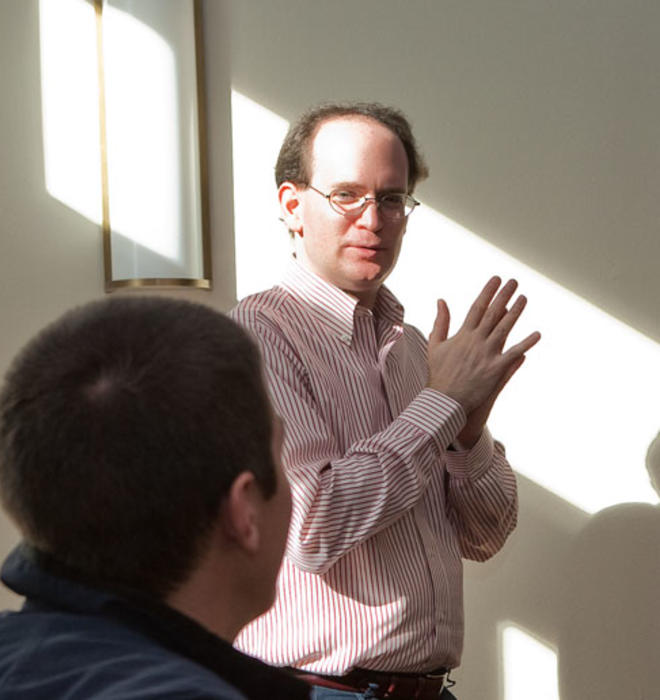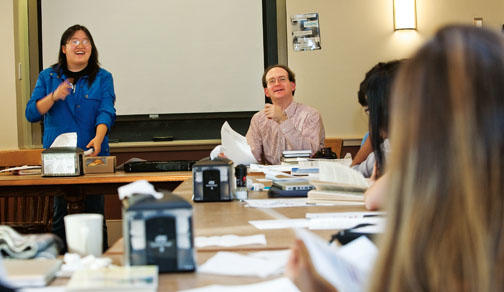
The first written assignment in Lily Akerman ’13’s freshman seminar was to produce a piece of “constrained writing,” and Akerman tackled it with a fervor that could not be explained simply by the fact that she was a first-year student, eager to prove herself.
“It kind of obsessed me,” she confesses.
Constrained writing is a literary form in which a restriction has been placed on word choice. Rhyme and meter are two very familiar forms of constraint. But there are many other, more abstruse constraints, such as banning the use of one or more letters (known as a lipogram) or requiring that every word begin with the same letter. This is a devilishly tricky thing to pull off, as you might imagine. It often yields writing we are more likely to marvel at than to enjoy.
After some false starts, Akerman decided to present two sides of a love affair gone wrong, between Ed and Ida. Her constraint was that both accounts had to use the same letters, in precisely the same order, but punctuated and spaced differently to present two very different sides of the same story. Ida’s version begins: “I’d aimed it at Ed. He artfully escaped intense wounds. Able, I fired a red gun. ... ” Some 40 words later, she concludes, “I mused.” Ed, as you might imagine, offers a very different take on things: “Ida,” he began, “I meditated. Heart full, yes. Caped in tense, wound sable. ... ” He ends in a cri de coeur: “I’m used!” While there are points at which the demands of her constraint dilute meaning, Akerman’s piece mostly makes sense.
“Really brilliant!” applauded Professor Joshua Katz, and the students agreed, voting hers the best of their efforts. Akerman was flattered but self-deprecating: “To somebody who’s not into wordplay, it must all seem so ridiculous.”
But she’s in good company here. The seminar is called “Wordplay: A Wry Plod from Babel to Scrabble” (in case you missed it, “a wry plod” is an anagram for “wordplay”), which is a bit misleading. Wry it may be, but a plod it’s not. The 15 students lucky enough to get picked by Katz for this seminar play games like Boggle and Scrabble; trade puns, pangrams, and examples of onomatopoeia from English and many other languages, including text talk and old computer languages; and read and discuss celebrated examples of constrained writing such as Georges Pérec’s novel La Disparition (“The Disappearance”) — in which the thing that has disappeared is the letter “e” — as well as Gilbert Adair’s translation of it, A Void, which does the same thing, but in English.
This might sound frivolous, but as Katz points out, it’s a very serious way to test and contemplate the limits of language, the relationship of form to content, and the way language works (or doesn’t). Says Katz, “By looking at things on a micro level and picking them apart in ways [students] don’t normally do, they get a new relationship with languages in general and, given the nature of what we’re doing, with English in particular.”
There’s a freewheeling, improvised quality to the proceedings, partly because most of this material isn’t part of any established curriculum. “I’m making things up because I’ve never taken a class on these things,” Katz admits. “So I’ve tried to gather a really smart group of people and see what happens.”
Here, almost anything goes. Monty Python’s Flying Circus and The Simpsons are as likely to provide examples as venerated masters of wordplay like Lewis Carroll, James Joyce, or Vladimir Nabokov. In one early class Emilly Zhu ’13 assigned everyone an anagrammatized name. Gary Fox ’13 was lucky: He became “Foxy Rag.” Poor Professor Katz? To this bunch, he forever will be known as “Zak juts a ho.”
While the seminar’s emphasis is unapologetically on the ludic side of things, it’s not just fun and games. Besides making several attempts at producing their own works of constrained writing, students also write a research paper on any subject involving wordplay. Gavin Schlissel ’13 was planning to write about how the accent in which a joke is told can alter its meaning and reception. This grew out of his own experiences during a year off in Germany where he made some killer jokes, only to have the locals assume, thanks to his American accent, that he was making clumsy mistakes. Rachel Chen ’13 focused on stand-up comedy, while Akerman was interested in portmanteau words, words blended together from other words, like “staycation” and “brunch.”
For a class in which everyone was instructed to bring in examples of wordplay from other languages, Amy Zhou ’13, who is teaching herself Finnish, brought a selection of Finnish tongue-twisters, palindromes, and a Finnish pangram (a sentence that uses all the letters in the alphabet, such as “the quick brown fox jumped over the lazy dog”). The class convulsed with laughter when she told them the translation offered was “muckysnogger booty-call.” Students moved on to bad jokes in Korean, examples of onomatopoeia from various Asian languages, and a few playful phrases from Harry Potter. There even was a discussion of “flyting,” a kind of verbal duel from Norse sagas that often commenced with insults to the opponent’s mother.
“Kind of like ‘Yo Mama,’ but in Icelandic,” said Foxy Rag.
What looks at times like competition is, the students insist, more an eagerness to share the best material with an audience they know will appreciate it. “Everybody really wants to bring something to the class that everybody else will enjoy,” says Michael Newman ’13.
Occasionally, things do get rather silly, as when Newman gives a short presentation on J.R.R. Tolkien’s Elvish, which leaves Katz looking on in (semi)feigned wonder, shaking his head and muttering to himself, “Oh dear, what have I done?” like a mad scientist whose experiment has gone terribly wrong. More often, though, Katz’s encyclopedic command of languages and linguistic theory steers the conversation back to serious points about how language works. Not that he’s terribly worried when things get silly.
Typically, Katz offers up a topic — wordplay in other languages, say — and expects the students to bring in the best examples they can find in the many languages they speak. This is not as impossible a task as it might sound, as the students include speakers of Chinese, Gaelic, Malaysian, Japanese, Korean, and various invented languages.
“I speak FoodTongue, if that counts,” says Krisin Cordwell ’13. FoodTongue, if you haven’t heard of it, is a language whose vocabulary is made up entirely of the English words for foods. It was invented a few years ago by the attendees of Canada/USA MathCamp. It’s not hard to understand how “Yo[gurt]” would mean “hello” and “Cheerio” “goodbye,” but things get a lot stranger than that.
There’s an unusual number of crack mathematicians in the class. Katz says that’s because they wrote great essays to get in, but it might also be that mathematicians are less wedded to everyday meaning and more likely to revel in abstract patterns than most people are.
Of course, it takes an unusual person to want to strip words of their meaning. Most of the students in the class wear their eccentricity as a badge of honor. “I was a pretty weird kid,” admits Newman. “When the other kids were climbing on the monkey bars, I was playing with my hand-held Scrabble game, trying to make words.”
Katz can relate to that. “I memorized grammars as a kid,” he admits, adding that he knew from an early age that he wanted to be a linguist, which, he points out, is not the same thing as a student of literature. “I’m very, very bad at meaning,” he says. “Possibly that’s one thing that pushed me in the direction of paying more attention to form than content. I don’t want to say that I’m not interested in content. But for me it all starts with the joy of paradigms on the page.”
Pink-faced and bespectacled, Katz has boundless enthusiasm for his subject. He goes far beyond teaching the class, inviting the students to lunch before class and scheduling movie nights, complete with popcorn, to show relevant films like Spellbound and Wordplay.
“Even e-mailing him is fun,” says Newman.
Katz has degrees in linguistics from Yale, Oxford, and Harvard, but since Princeton does not have a linguistics department, he wound up in the classics department, grateful to get the chance to teach a class like this, which he hopes to offer again. The students have been trying to pry from Katz how many languages he actually does speak. Dozens, he allows. His more formal understanding of linguistic theory and his command of all those languages mean that he’s excellent at stopping the insanity to make serious points about grammar, pronunciation, and spelling. And make no mistake: There are serious points to be made — about how languages evolve, how they work, and yes, “how” they mean.
“What I’m doing,” he says, “is looking at this stuff that is definitely not normal and yet, most of the time, is language, in order to figure out, in effect, what the boundaries of language are.”
Katz understands Lily Akerman’s obsession perfectly well. There is something in all of us, he says, that craves wordplay. “That’s one of the things that’s so interesting about it,” he muses. “It resonates so seriously with children the world over, [in the form of] puns, oral games, rhymes, and songs.” As we get older, most of us stifle our fascination with it. But these lucky students, with Katz as their guide, are rediscovering the deep and serious pleasure of playing with words.
Merrell Noden ’78 is a frequent PAW contributor.
Try your hand at constrained writing and you could win a trio of DVDs for word lovers: “Spellbound,” “Wordplay,” and “Word Wars”!
Lipograms (banning a particular letter), palindromes (reading the same backward and forward), alliteratives (each word starts with the same letter), anagrams (rearranging the letters in a sentence, for example, to create a new sentence) — whatever your puzzle passion, send your example by March 1 to paw@princeton.edu or to “Constrained Writing,” Princeton Alumni Weekly, 194 Nassau St., Suite 38, Princeton, NJ, 08542. We plan to post submissions and announce the winner in the April 7 issue. To see students’ work, click here.







No responses yet